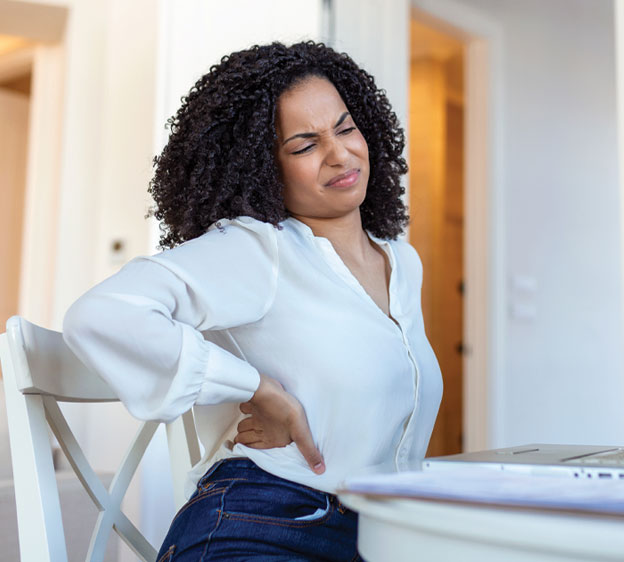
After colds and the flu, low back pain is the top reason people in the United States visit their health care provider. Pain in the lumbar spine, or lower back, is often accompanied by a tight lower back, decreasing flexibility and making standing upright or changing positions challenging. Lower back stiffness has many possible causes, including arthritis, nerve damage, a strain or sprain, or ankylosing spondylitis. If you have mild lumbar tightness without additional symptoms, these five techniques may bring some relief.
1. Warm Up or Cool Down
Depending on the cause of the tightness in your lower back, applying a hot or cold pack can help ease discomfort.
“Placing a warm compress on the lower back causes blood vessels to widen,” says Mary Descaro, physical therapist at Beaufort Memorial Outpatient Rehabilitation Services. “For chronic conditions, such as arthritis, this decreases stiffness, improves blood flow and relaxes muscles. For overworked or newly injured muscles, a cold compress narrows blood vessels and lowers inflammation in the area.”
Read More: Exercise: A Quick Fix for Lower Back Pain
2. Sit Up Straight, But Not for Too Long
Poor sitting posture may lead to stiffness and pain in the lumbar spine. Choose a chair that lets you put your feet flat on the floor with hips at 90 degrees and supports your spine. If your chair lacks support for the curve of your lower back, place a small rolled-up towel between your lower back and the chair.
Even if your sitting posture is perfect, you can get too much of a good thing.
“Prolonged sitting can cause stiffness in the muscles that flex and extend the hip, including the hamstrings,” Descaro says. “This can lead to increased tightness and pain. If you need to sit for long periods, get up, move and stretch for a few minutes every half hour.”
Read More: Coping With Chronic Back Pain
3. Strike a Pose and Stretch Your Tight Lower Back
Many yoga poses gently stretch muscles in your back, hips and pelvis, increasing flexibility and strength while reducing stiffness. Here are a few poses to get you started:
Cat-Cow Pose
- Get on your hands and knees, with wrists below your shoulders and knees beneath your hips.
- Inhale deeply as you slowly lift your head to look at the sky and let your back relax down, lowering your belly toward the floor.
- Exhale and arch your back up to the sky slowly while lowering your neck in line with the curve of your back.
- Repeat five times.
If you’re not able to get down on the floor, stand and lean forward and put your hands on a counter or another sturdy surface. Keep your elbows straight and gently push through your hands while arching your back upward.
Modified Child’s Pose
- Stand comfortably a few steps back from a countertop.
- Extend your arms and place your palms flat on the surface.
- Walk your hands forward while bending at the hips, keeping your back straight.
- Keep your body — from your hands to your tailbone — flat like a table and hold for five to 10 seconds.
Lying Trunk Rotation
- Lie on your back with your knees bent and feet on the floor. Keep your right and left knee close together.
- Extend your arms out to your sides.
- Gently rotate your knees to the left side, keeping your back and right shoulder flat on the floor.
- When you feel the abdominal stretch, pause and hold for five to 10 seconds.
- Slowly bring your knees back up.
- Stretch three to five times in each direction.
Read More: Could Good Posture Be the Secret for Getting Rid of Back Pain?
4. Relax Your Mind to Relieve Your Tight Lower Back
High stress levels can cause or worsen lower back tightness. Decreasing stress may help relieve pain and loosen tightness in the lumbar spine. To lower stress, try:
- Connecting with loved ones
- Practicing gratitude
- Spending time in nature
- Taking slow, deep breaths
5. Return to Your Core
Increasingly common as we age, balance and coordination issues are caused by a combination of factors, including decreased abdominal muscle strength and changes in body awareness.
“Loss of core strength causes decreased stability in the lower back,” Descaro says. “To help protect the spine, your body may compensate for muscle loss by tightening muscles. However, your body can go too far and cause too much tightness, which, in turn, leads to lower back pain.”
Exercises to strengthen core muscles and improve balance and coordination can add stability while relaxing lower back tension. Talk with your health care provider to get started. They can recommend exercises or refer you to a physical therapist for more support. If you have arthritis, aquatic exercise or tai chi may be good options to improve core strength while going easy on your joints.
Request an appointment with a Beaufort Memorial spine specialist to learn more ways to manage or treat a tight lower back.
